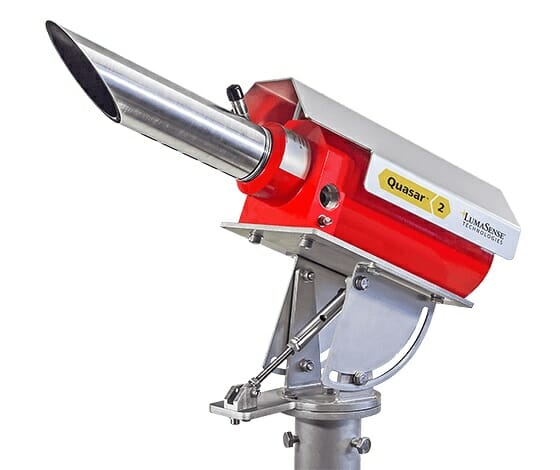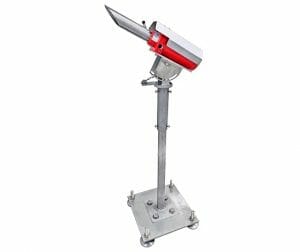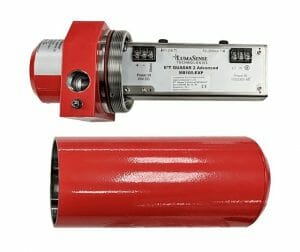Safe flare operation and environmental protection require reliable and accurate flare pilot monitoring.
Flaring systems are commonplace across many industries, perhaps none more so than in oil and gas, and are used to burn gases before they enter the atmosphere. Safe operation of a flaring system requires the continuous monitoring of pilot flames and flared gases to ensure that vented gases are ignited.
Efficient flare stack operation requires pilot monitoring to ensure there is a pilot presence 100% of the time for safe operation, environmental assurance and governmental compliance. Pilot thermocouple failures are common, so secondary redundant monitoring methods are often installed in new applications or as aftermarket installations to enhance a failing thermocouple issue.
Alternative flare monitoring technologies are provided by infrared pyrometers and imaging pilot monitoring systems. These can range from basic solutions that provide the pilot status, to more advanced solutions that detect the different flame sizes and can differentiate between pilot flames, flare flames, and multiple flare tip.
For example, pyrometry could be used in single flare tip applications to detect if the pilot flame is on or off. Likewise, pyrometry or thermal imaging can be used to provide stage level indication in staged flare applications or for monitoring gas-assist flaring applications to maintain accurate flaring levels. And when monitoring multiple flare tips that are in close proximity, advanced solutions can be used that integrate both Pyrometer systems and Thermal Imaging systems to differentiate between each flare and pilot flame for more accurate flare monitoring.
Site requirements also demand that flare monitoring technologies be sensitive to small flames to allow flaring detection from further distances, and to be packaged into a compatible housing for harsh environmental conditions and hazardous areas.
A range of infrared technologies are available in the market, including the new pyrometer-based product that was recently released by LumaSense Technologies– E2T Quasar 2.
This development of specialized enclosures, electronics, and optics specific to a flare monitoring application has the highest performance and capabilities available to the flare market and allows for pilot monitoring from greater distances than previously possible. The scalability of the new flare monitoring systems and their ability to integrate multiple monitoring technologies through software, allows for a flare monitoring solution for all the market flare monitoring needs.
LumaSense has made a large investment into the development of customized flare monitoring solutions. This includes the upgrade of the current Quasar pyrometer system with the release of the new Quasar 2 system. The Quasar 2 is a pyrometer-based technology, adding higher-end capabilities to monitor staged flares and gas-assist flares.
The E2T Quasar 2 series of monitoring and detection instruments are designed for continuous duty monitoring of pilot flames and flared gases from flares. The base system provides low-cost basic flare pilot monitoring capabilities. The advanced model has an intensity mA output that allow for a setpoint mA level to be set in a client’s DCS for both the pilot and flaring status signals levels from a single unit. Additional add-on features are also available for configuring the Quasar 2 system to meet a wide range of client flare types, monitoring requirements, and budgets.
This product offers a new stainless-steel enclosure for reduced corrosion and increased suitability for marine applications. Two models are available: Quasar 2 M8100-EXP and Quasar 2 M8100-EXP Advanced. Scalable options are available with the advanced version including continuous 4-20 mA, peak hold and decay, and power supply with 24V DC, and 85 to 265V AC input.
High-resolution optics and selection of various spot sizes enables the Quasar 2 to be positioned as far as 400 meters from the flare stack being monitored and ensure the highest flame signal detection. Alignment on the target is accomplished through the targeting port and the signal intensity LED bar displays amplitude in combination with a stable M-4 Heavy Duty Swivel Mount.
Custom electronics adapt to target movement, varying luminosity, and most climate conditions. The alarm delay circuit can be adjusted for a specific location or application, eliminating false alarms from temporary loss of signal due to intermittent flames, adverse weather, and wind. The set point feature of the advanced unit can also be used for staged flares and will provide feedback on the staged flare status.
Typical Applications for the use of Quasar 2 systems include:
- Elevated Flares (either steam- air- or gas- assisted)
- Ground Flares (burn pit-flares, ground flare arrays)
- Off-Shore Flares
- Staged Flares
LumaSense Technologies owns 25 years of experience in offering our Quasar Flare Stack monitoring pyrometer solution. With proven technology, reliable instrumentation and installations at over 550 petrochemical facilities worldwide, customers know they can trust the LumaSense E²T line of petrochemical infrared sensors.
Contact:
LumaSense Technologies GmbH–
An Advanced Energy Company
www.lumasenseinc.com
LTI-[email protected]











